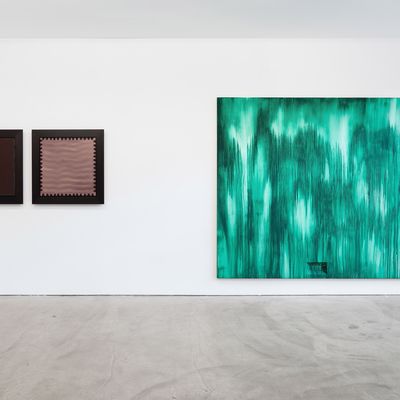
As a noxious cloud of anemic abstract painting and sculpture continues to blanket the art world ÔÇö and┬á junior postmodernists churn out handsome harmless knockoffs, all involving scraping, scribbling, silkscreened images, spray paint, stenciling, staining, and some drips ÔÇö a small survey of the late Moira Dryer is a quickening pick-me-up. The day Dryer died from cancer in 1992, at just 34, the art world lost a great gritty painter. Starting in 1986, her work startled the art world, then stuck in a similar rut of cool formalist abstraction. This eight-painting show couldnÔÇÖt be better timed.┬á
Dryer used stripes, drips, dots, and squiggles, tropes and motifs that even then were a half-century old. (And are the configurations painters today are still using.) Yet her shaped, strange paintings, sometimes with wavy edges, indentations, bumps, drilled holes, and panels propped against walls or set on logs, have an energy that doesnÔÇÖt just piggyback on older abstraction. Her casein-on-plywood brushwork has a dry, friction-filled fluidity to it. Skewed and skittering marks are set just so, auroras of iridescent color pulsate or go rogue, surfaces feel invented but also recovered from patterns already there. All this gives DryerÔÇÖs work visual juice ÔÇö something that makes it feel flaunting, present, and not false.
That flaunting not-falseness is evinced at Eleven Rivington.┬áFor viewers unfamiliar with DryerÔÇÖs art, note the visual and literal physicality of her work ÔÇô how things are built, made, manipulated, textured. Dryer said she wanted her paintings to be ÔÇ£constantly transmuting into a new identity.ÔÇØ That means she didnÔÇÖt see painting as a noun ÔÇö a thing just to be contemplated ÔÇö but as a verb, something that does something, that┬áhappens, to us. SheÔÇÖs anti-Platonic this way; nothing cool and conceptual here. Embrace this insatiable satyrlike impishness, and youÔÇÖre halfway there. Her color, light, and touch will take you the rest of the distance.
As seen at Eleven Rivington, DryerÔÇÖs constructed shapes, pieced-together diptychs, and propped panels are antecedents to much of the better literalized, concrete, physical abstract painting being made well now by artists like Hayley Tompkins, Lisa Beck, Wendy White, Keltie Ferris, Katherine Bernhardt, Ulrike Muller, and Sarah Crowner. All these artists are pushing and expanding the form in ways that almost makes the word┬ápainting┬áfeel inadequate.┬áThe Signature Painting,┬áfrom 1987, has a┬áfaux┬áwood surface of concentric rectangles and the artistÔÇÖs initials rendered in elaborate looping letters. The initials are a place from which to make forays and return, something like text melding into doodle, decoration, nest, and autobiography. Beneath this is an angled shelf painted in the same faux-wood pattern. This turns into a perch or lectern that draws on much older latent pictorial energy, transforming into a predella ÔÇö a painting beneath a painting that comments on both. ItÔÇÖs wild to have a quasi-formalist painting get this wonky and break free of formalist discourse. Are you listening, all you locked-in postmodernists?┬á
A casein-on-wood piece from 1989,┬áNot titled,┬áis an almost-monochrome stained plywood, like a bed mounted on the wall that curls outward at the top. The whole object becomes like a body, board, or semi-geometric hide ÔÇö maybe an animal-like piece of geometry.┬áCaptain Courageous,┬áfrom 1990 and seen above right, a stained drippy monochrome, has a drawerlike indentation or divot in it. The thing is like one of Donald JuddÔÇÖs ÔÇ£specific objects.ÔÇØ Not quite a painting, not a sculpture or piece of furniture, itÔÇÖs something different and specifically itself, something that can be taken in at one glance. This is painting breaking free, maybe even escaping the word.┬á
DryerÔÇÖs painterly path was cut very short. This makes it all the sweeter that in the galleryÔÇÖs nearby annex at 195 Chrystie Street, you can see work by a number of artists like Mary Weatherford, Mika Tajima, Julia Dault, and Jackie Saccoccio, all of whom are making good on ideas that Dwyer put so masterfully into play twenty years ago. Vita brevis, ars longa, indeed.┬á
ÔÇ£Moira Dryer ProjectÔÇØ is at Eleven Rivington through February 22.┬á

